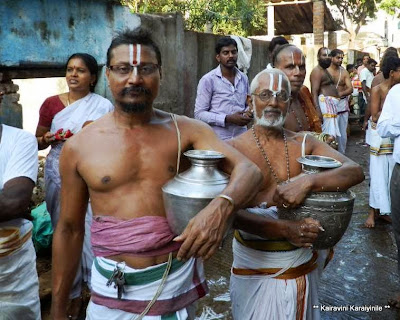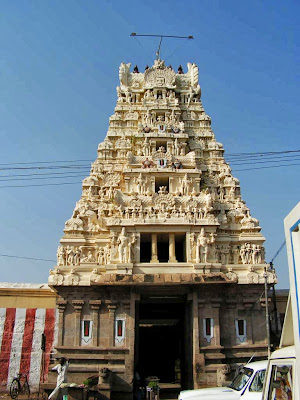Sri Vaishnava temples follow
the doctrine and practices instituted by our great Acharyar Sri Ramanujar. In most Divyadesams, one would be impressed by
the resplendent splendour of Archavathara Murthies, the garlands and floral
decorations, the ornate ornaments, the devoted services of Battars, Veda
Adhyapakars rendering Vedas and Divyaprabandhams, the Sripadham thangigal who
with mighty devotion take the Lord on their shoulders and there is more…
In the lineage of great
Acharyars of our Sampradhayam – Sriman Nadhamunigal is in the midst. After the
great Azhwars, there was a period when the ‘divyaprabandhams’ rendered by them
were lost in oblivion; it was Sri Nathamunigal who got them back; he is
credited with the regenesis of ‘Divya
Prabandham’. Sri Nathamunigal was a
great Bhakti Yogi and practiced the Yoga of eight accessories ( ashtAnga yoga);
he authored the treatise “Yoga
Rahasya”. He was also an exponent of
divine music who initiated the ‘singing
of divyaprabandham ~ now known as Arayar Sevai’.
The “Araiyar Sevai” is a
unique offering that takes place on certain specific occasions at a few divyadesams
– Thiruvarangam, Srivilliputhur, Thirukurugoor [Azhwar Thirunagari],
Thirukkannapuram…. It is bakthi in its
purest form – rendered by special people – who sing the verses of Nalayira
Divyaprabandham accompanied by abinayam [gesture] with ease. Araiyars
are hereditary and take great effort to preserve their family tradition,
descending from the days of Acharyar Nathamunigal…. Sadly, there are not many
as over the years we have failed to recognize and take care of their exquisite
art totally dedicated to Sriman Narayana.
Though there are
administrators and the department is getting huge revenue, some temples are in
the state of neglect, manuscripts are not properly preserved and traditional
fine arts practised for centuries in temples are slowly forgotten due to long
years of neglect. `Araiyar Sevai’ is the
visual enactment of the passionate expression by those in the
tradition of Araiyars who have upheld the literature of Iyal, Isai and Natakam.
The Araiyars are not mere dance performers
~ being well versed in Vaishnavaite commentaries possessing great knowledge. Have
read that according to ‘Koil Ozhugu’ record book of the Srirangam temple, Thirumangai
Azhwar, started the practice of presenting Thirunedun thandakam with the
accompaniment of music before Lord Num
Perumal; ages later, Nathamunigal introduced its performance during the
Thiruvadhyayana Uthsavam. His nephews - Keezhai Agathu Azhwar and Melai
Agathu became the foremost Araiyars at Srirangam. According to tradition they were given a
cone-like cape “Ariyar Kireedam,'' two cymbals and the sacred garlands by the
Lord of Srirangam Himself. The Araiyars
first recite the Paasuram, they then explain its inner meaning and finally
perform the Abhinaya, a unique art/dance performance with their hands and legs
explaining the Paasurams with special musical effect.
Adiyen Srinivasa dhasan.
One of the few committed
to and continuing the traditions of Araiyar Sevai is ‘Srinivasachariyar of
Srivilliputhur’ - Here is the
article that appeared in The Hindu dated 8th Aug 2013. The article
source can be followed here : http://www.thehindu.com/features/friday-review/dance-of-devotion/article5003192.ece?homepage=true [news and photos courtesy : The Hindu]
The over 1,000 years
old art of Araiyar Sevai, which was once performed across Divya Desams, has
seen a decline in recent times (it is now performed only in Srirangam,
Srivilliputhur and Azhwar Tirunagari), one Araiyar is not ready to give up. In
the eighth decade of his service to the Lord, Srinivasachariyar of
Srivilliputhur performs Araiyar Sevai with the same devotion with which he
started way back in 1943, when he was just 13 years old.
It would be
appropriate to recapture the origin of Araiyar Sevai. Vaishnavite Savant
Nadhamuni, who lived in the 9th-10th Century A.D., wished to make sure that
Naalayira Divya Prabandham was preserved. What better way than to give them a
musical shape and gestures to go with it? Aided by his nephews, Keezhaiyagath Azhwar
and Melaiyagath Azhwar, Nadhamuni created special ragas and talas for the
paasurams. Araiyar Sevai was born. Lord Ranganatha of Srirangam is believed to
have gifted the Araiyars (Kings of Music) the cone-like cap, two cymbals and a
sacred garland to be worn around their neck during performance.

Born in Srivilliputhur
on Pooram day in Purattasi in 1930, Araiyar Srinivasachariyar, a descendent of
Melaiyagath Azhwar, was initiated into this special art of presenting the
sacred verses by his father Araiyar Vadapatrasayee at the age of seven. The
learning process that spanned 18 long years included singing the paasuram in a
special tune with the relevant raga, practising abhinaya and presenting the
Vyakyanam every morning at 4 and again in the evening at 9. The entire process
involved not just acquiring knowledge of the 4,000 divine songs of the Azhwars
but also the monumental task of capturing the meaning of each of these
Paasurams and then reaching out the essence of these verses to the audience.
The Vyakyanam for the Thiru Pallandu verses alone runs into 70 pages!
Araiyar
Srinivasachariyar has fond memories of his Arangetram in 1943 “I really felt
honoured to be led by a music band with ‘melam and thaalam’ and the temple
elephant with an umbrella over me and a sacred chamaram (to fan me) around the
streets of Srivilliputhur and then into the Andal Sannidhi, Vadabadrasayee
Sannidhi and the Peri Azhwar Sannidhi. I was presented with the ‘Kreedam,
Parivattam and Peetambaram.’ That was a divine moment.” In the same year, he
presented his first ever Araiyar Sevai in front of Tirukurungudi Nambi, his
Kula Deivam, performing the abhinaya for Thirumangai Azhwar’s Periya Thirumozhi
verse ‘Akkum Puliyum’ and Nammazhwar’s Tiruvoimozhi paasuram ‘Enganeyo’. Since
then, for decades, he has been presenting these two verses at the
Thirukurungudi Divya Desam on Kaisika Ekadasi.
His selfless service
and devotion assume greater significance as many Araiyars even within these
three Divya Desams where Araiyar Sevai is being performed have looked for
financially ‘greener’ pastures (corporate world). He has had the unique honour
of being invited to present Araiyar Sevai in over 30 Divya Desams in the State,
including Sarangapani Koil, Nachiyar Koil, Thiruchcherai, Azhagar Koil and Thiru
Nagai. He particularly remembers his first such presentation at the Sri Parthasarathy Swami temple in Triplicane, exactly fifty
years ago in 1963, in front of a big audience.
Cherishing those
special moments, Araiyar Srinivasachariyar says, ‘It was a privilege to travel
to these to renowned Divya Desams and present Araiyar Sevai for long hours.
Devotees used to gather in thousands and would watch in pin drop silence the
presentation that would sometimes go late into the night.” All through this
70-year service he has been presenting Araiyar Sevai at Srivilliputhur on all
festive occasions such as Aadi Pooram, Panguni Uthiram and the 20-day Adhyayana
Utsavam.
the cymbals and the Kireedam
Through his story
telling, Araiyar Srinivasachariyar transports listeners to a different world
peopled by gods, goddesses and demons. Andal grows into a beautiful young girl,
Lord Vishnu demolishes the evil forces - Kamsa and Hiranya - Lord Naryana retrieves
the nectar and hands it back to the Devas and Lord Rama’s triumphs over Ravana
as he sings the verses of Azhwars with appropriate abhinaya.
In the Himalayas
: The most memorable experience of his life was his trip in 1978 to the Himalayas, where he presented Araiyar Sevai in front of
Lord Badri Narayanan at the Badrinath Divya Desam. His eyes light up as he
recounts that trip. “I was sitting outside my house in Srivilliputhur when an
astrologer passed that way. I told him I wanted to go North. He suggested that
I leave for my trip that same day. I left immediately for Madras
and from there I went to Hyderabad
and met Sriman Narayana Jeer. From Secunderabad, I went to Badrinath and stayed
in the Himalayas for nine days.”
Tears well in his eyes
as he continues: “It was God’s grace that I was able to present Araiyar Sevai
at 3. 30 a.m. in front of the Lord. Almost everyone was shivering as it was
extremely cold. But I was out there presenting Araiyar Sevai. My entire thought
centred on Badri Narayana Perumal and I was oblivious of the temperature that
must have been several degrees below zero.” Moved by his dedication, Sriman
Narayana Jeer honoured him with the title ‘Bhagavad Vishaya Vidwan’. His two other
favourite presentations which he savours are Thirumangai Azhwar’s ‘Thooviriya
Malar Uzhakki’ Periya Thirumozhi verse praising the Lord of Thiruvali Divya
Desam presented in Deva Mukhari Ragam and the Thiru Nedunthaandagam verses –
both during the Pagal Pathu Utsavam in Margazhi. Araiyar
Srinivasachariyar Swami can be contacted at 9443867345
Admirers’ appeal : The
wish of all those who have been following the service of Srinivasachariyar
Swami is that he should be conferred Kalaimamani by the Tamil Nadu Government.
Araiyar Sevai, after all, is a unique combination of music, dance and devotion.
The 400-year old house of Araiyar Swami on Periya Perumal West Mada Street in
Srivilliputhur is in bad shape. Swami has been presenting Araiyar Sevai for
seven decades without financial support of any form. Nor has he been tempted by
offers by cinema producers and visitors from abroad to video film his
performance.
Tomorrow at
Villiputhur : Araiyar Srinivasachariyar Swami will present his special ‘Muthu
Kuri’ Araiyar Sevai tomorrow evening (August 10) at Srivilliputhur Divya Desam
as part of the tenth day celebrations of the Aadi Pooram Utsavam. He is set to
present Araiyar Sevai at the Nadha Muni Thiruvarasu in Chokka Pallam, east of
Gangai Konda Chozha Puram, on September 15 on the occasion of the Samprokasham
of the shrine. The performance, of course is being dedicated to the saint, who
introduced Araiyar Sevai.
Highlights:
1943 –
Arangetram at the Andal shrine, Srivilliputhur
1943 - First
presentation at Thirukurungudi
1963 – Araiyar
Sevai at Parthasarathy temple in Thiruvallikeni
1970s -
Performs at Tirunaraiyur, Sarangapani temple, Srimushnum and Azhagar Koil
1978 - Araiyar
Sevai in the Himalayas in front of Badri
Narayana Perumal.
2007 –
Presentation at Ashtalakshmi temple, Chennai
2009 -
Velukkudi Krishnan confers on him the title, ‘Kainkarya Srimaan.’
the Araiyars of Srirangam








































.jpg)


